England
1872-1939
 The Football Association (FA) was formed on 26 October 1862 by representatives of ten English clubs who sought to create a unified set of rules and a framework for future competition. Unlike every other national association, the FA does not include the name of its host country in its title. It was not until ten years later that the first international fixture took place, against Scotland. The Scottish, Irish and Welsh Football Associations were formed shortly afterwards and in 1883 the Home Nations Championship was inaugurated.
The Football Association (FA) was formed on 26 October 1862 by representatives of ten English clubs who sought to create a unified set of rules and a framework for future competition. Unlike every other national association, the FA does not include the name of its host country in its title. It was not until ten years later that the first international fixture took place, against Scotland. The Scottish, Irish and Welsh Football Associations were formed shortly afterwards and in 1883 the Home Nations Championship was inaugurated.
Sources:
 1872-1900
1872-1900
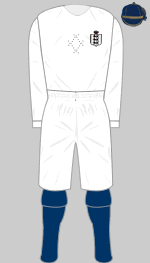
1872
Club shirts worn with FA crest.
1875-1879
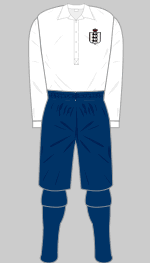
1879-1900
White, black and navy knickers worn
Designer:
On 30 November 1872 at the ground of the West of Scotland Cricket Club in Glasgow, the first ever international association football match took place between England and Scotland. Representative matches between English and Scottish players (some of whom had tenuous connections with Scotland) had been organised earlier but as both teams were chosen by the English FA committee, these are not considered to be true international matches.
England wore white jerseys emblazoned with the three lions crest of the Football Association, white knickers, navy hose and caps. Players probably provided their own jerseys, at least one of which had a diamond design woven into the fabric in the centre of the chest.
A report in the Sheffield Independent from March 8 1875 indicates that the English players wore their club tops in the match with Scotland and we have now confirmed that when England met Wales for the first time (18 January 1879) the players again wore their own club shirts. From this we can infer that the team did not have a regular uniform during this period.
Research by Glen Isherwood has established that between 1879 and 1882, the FA purchased collared shirts from Messrs Gann, Root & Co of 171, Fenchurch Street, London. This followed press criticism of the otley appearance of the team against Wales earlier that year. The company went out of business in 1882 and there are no records of where shirts were sourced from after that but it is clear that the FA were providing players with shirts (but not knickers or socks) from 1879.
In March 1882 England wore navy blue knickers, perhaps for the first time. It appears, however, that both white and dark knickers were worn (often in the same game) at least until 1897.
In 1883-84 the Home International tournament was established. The backbone of the team throughout the Eighties was the Corinthian club, formed to bring together the leading gentlemen-players to challenge the dominance of Queen's Park, who provided most of the Scottish team that regularly outplayed the English. In "Beastly Fury" (Bantam Press 2009), Richard Sanders records that when JH Forrest of Blackburn Rovers became the first acknowleged professional to be selected for England, he was required to wear a differently coloured shirt to his team-mates. Such were the social attitides of the time that the amateurs ostracised the professionals until the balance shifted in favour of the better trained pros by the end of the decade.
 1900-1914
1900-1914
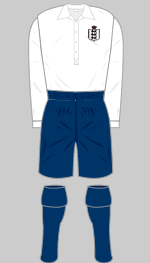
1900-1914
Club shorts/socks worn
Designer:
As the popularity of association football spread beyond the United Kingdom so did the need for an overall governing body. The four Home Associations rejected the idea and it was left to the Football Associations of Belgium, France, Denmark, the Netherlands, Spain, Sweden and Switzerland to form the Fédération Internationales des Football Associations (FIFA).
An intriguing image of James Iremonger, who played for England three times in 1901-02 including an unofficial international against a German Select XI in 1901 (seven years before the DFB was formed) shows the player in a dark shirt with the FA crest. I now believe that he removed this from his international shirt and had it sewn on to his Nottingham Forest shirt.
England joined FIFA in April 1905 and played their first official games against European opposition on a tour in June 1908, when they contested three matches against Austria, Hungary and Bohemia (all part of the Austro-Hungarian Empire). These were the only teams from outside the British Isles that England played prior to the outbreak of the First World War.
Although the FA provided the flannel shirts, players were expected to provide their own navy blue knickers and (usually) wore their club stockings.
 1920-1939
1920-1939
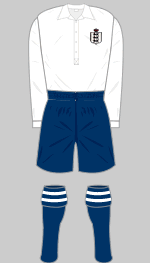
1920-1932
Club shorts/socks worn
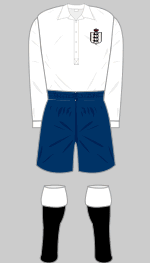
1932-1934

1934-1938
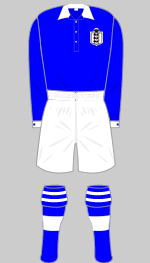
1935 change
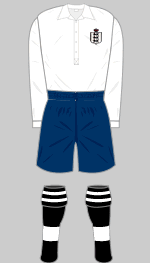
1938-1939
Designer: St Blaise
The Home International competition resumed in April 1920 when the UK associations effectively boycotted FIFA. As a result of this short-sighted policy, England did not take part in the inaugural World Cup in 1930 nor the 1934 competition, held in Italy. Players continued to wear their club knickers and stockings until 1932 when the FA, prompted no doubt by press criticism about the team's amateurish turn out, finally issued standard sets of navy knickers and black socks with a white turnover. The socks were modified in 1934 and again in 1938.
A change shirt was required for the first time in 1935 when Germany were the visitors, losing 3-0 at White Hart Lane. This is the only occasion on which England did not wear their traditional white shirts prior to 1939.
Numbers were worn on the back of players' shirts for the first time during a tour of Scandinavia in May 1937.
Home Nations Index Page |
England 1946-1960 >
 The Football Association (FA) was formed on 26 October 1862 by representatives of ten English clubs who sought to create a unified set of rules and a framework for future competition. Unlike every other national association, the FA does not include the name of its host country in its title. It was not until ten years later that the first international fixture took place, against Scotland. The Scottish, Irish and Welsh Football Associations were formed shortly afterwards and in 1883 the Home Nations Championship was inaugurated.
The Football Association (FA) was formed on 26 October 1862 by representatives of ten English clubs who sought to create a unified set of rules and a framework for future competition. Unlike every other national association, the FA does not include the name of its host country in its title. It was not until ten years later that the first international fixture took place, against Scotland. The Scottish, Irish and Welsh Football Associations were formed shortly afterwards and in 1883 the Home Nations Championship was inaugurated.






